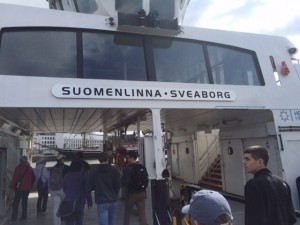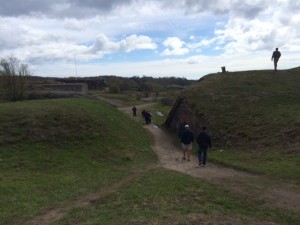Suomenlinna Fortress
by guest bloggers Stanton Wiggins and Adam Elhammoumi
Many of us grabbed breakfast at different places before meeting in the hotel lobby at 10:30 to start out the third day. Dr. Rojas was waiting in the hotel lobby with us and led us to the ferry harbor, about a fifteen minute walk to the south. As we reached the harbor, we boarded a ferry to Suomenlinna, a fortress island originally built by the Russians in the 18th century. The ferry ride was about 15 minutes, and seagulls followed the boat the entire way to the island because they are used to being fed by its passengers. Once we arrived, we broke into several small groups and headed in different directions to explore the island.
One of the smaller groups accidentally walked over to a “restricted” part of the island and had a chance to explore a Finnish naval training ground before realizing we were not allowed to be there. After being politely asked to return to the main island, we visited the large, central church. The church was described as one of the oldest buildings remaining on the islands and was Lutheran in denomination.
After seeing the Lutheran church, we walked a long loop around the outside of the center island. This island was used during the Winter War to defend the nearby Finnish ports. There were many large cannons around the outskirts of the island, some of which were designed to fire cannonballs and others were designed to fire explosive shells. There were also lots of bunkers, many of which connected by unlit tunnels, buried underneath grassy hills. Given the size and number of the cannons on the island, we speculated that the bunkers were used both for the storage of munitions and for cover when the island was under fire from enemy ships’ cannons. Interestingly, the bunkers on the island looked much like the homes in The Shire from Lord of the Rings – despite serving a military purpose, the central island was quite beautiful.
After walking around the central island, many of us went through the unlit tunnels connecting the area with cannons to the King’s Gate, a large, ornamental, fortified gate leading to a dock for royalty to enter and leave the island. There were many gun ports through which riflemen could fire on attacking ships at the gate, as it was located on the corner of the island and relatively exposed. The King’s Gate is perhaps the most well-known part of the Suomenlinna fortress.
From the King’s gate, we once again looped around the island and headed back in the direction of the ferry. By now, we had spent about two to three hours on the island and we needed to reconvene to make the 2:15 ferry back to mainland Helsinki. As more and more of the smaller groups returned to the docks, many students purchased some food and souvenirs at nearby restaurants and gift shops. Dr. Byrd purchased a small box of Salmiakki, a Finnish hard candy described as “salted black licorice”. Of all the students that tried the candy, only one or two actually liked it – most Finns would describe it as an “acquired taste”.
After relaxing at the restaurants and shops for half an hour, the ferry returned to the island and it was time to head back to mainland Helsinki. Once returning, we again split into smaller groups and many students stayed near the harbor to explore the open air market. The market had many vendors operating out of small tents and selling handmade Finnish goods, various foods (Finnish and otherwise), souvenirs, and miscellaneous trinkets. Several of us stopped at a “Lapland Foods” tent and purchased reindeer sausage and other Finnish smoked meats for lunch – a delicious meal! After spending some time at the market, most of us returned to the hotel and spent some time in the sauna before going our separate ways for a free evening.



- Categories: